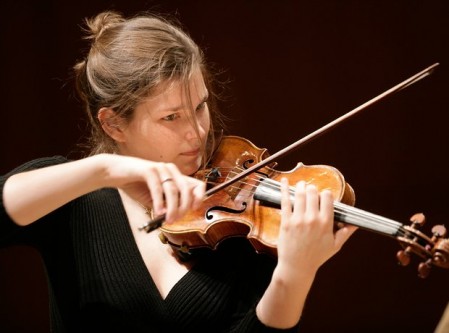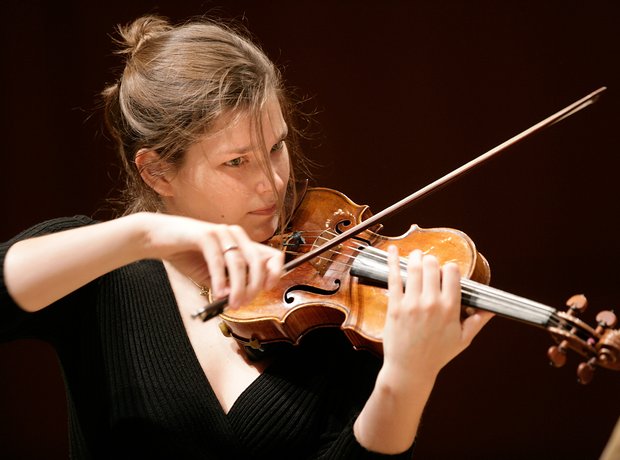 United Kingdom Brahms and Bruckner: Janine Jansen (violin), London Philharmonic Orchestra / Vladimir Jurowski (conductor), Royal Festival Hall, London, 3.5.2019. (AS)
United Kingdom Brahms and Bruckner: Janine Jansen (violin), London Philharmonic Orchestra / Vladimir Jurowski (conductor), Royal Festival Hall, London, 3.5.2019. (AS)

Brahms – Violin Concerto in D, Op.77
Bruckner – Symphony No.3 in D minor, WAB103 (1877 revision)
In this concert we heard the Third Symphony of Bruckner, or about two thirds of it. If this seems a flippant remark, the cut 1877 version of the work performed under Vladimir Jurowski’s baton, though made by Bruckner himself, was undertaken by the demoralised composer after the first performance of the original 1873 version had been very badly received. Bruckner himself had had to act as replacement conductor and the performance was apparently inadequate. The composer’s cut version was then subjected to meddling by various editorial hands and still more revisions were published. In 1978 Leopold Nowak published an edition of the much longer original score, based on Bruckner’s own fair copy. But conductors have continued to perform one or other of the truncated versions. Yet, as Georg Tintner wrote in the notes for his own recording of the 1873 score, the ‘work as originally conceived suffered by its progressive mutilations more and more, and we should take the time to play and to listen to this amazing original.’
Enough said about that. Taken on its own terms, this was an excellent performance, in the manner that we have come to expect of Jurowski’s Bruckner. He is not one to linger over detail in the manner of many of the old conductors of yore. His is a straight from the shoulder delivery of the music, not hurried, but paced in such a way that the overall structure of the music is clearly and logically revealed. This approach paid particular dividends in the second movement Adagio, which was kept flowing very satisfyingly, but with time found within for some charmingly tender phrasing. The Scherzo had an appealingly bouncy nature, with the same characteristic well maintained in the already playful trio. Detail in the finale was skilfully dovetailed: everything had its correct place within the whole span of the movement. It wasn’t a performance for every day, though Jurowski’s adroit, sensitive managing of phrase ensured that a more overtly romantic approach to the music was not too much missed.
Even at the very beginning of the Brahms Violin Concerto Jurowski conducted one in a bar instead of three and continued to do so. His resourceful baton technique ensured that the beat was clear enough, and the opening paragraphs thus seemed to float into being rather than being defined rhythmically. This was a highly effective preparation for Janine Jansen’s urgent, arresting entry, and the dialogue between soloist and orchestra proceeded very satisfyingly. Jansen struck an ideal balance between lyrical, warm-hearted expression and a clear, classical approach to the music. Her silvery tone quality was also very appealing to the ear. She maintained the same balanced stance in the Adagio. Jurowski ensured that the excellent solo oboe playing of Ian Hardwick at the beginning of the movement was kept flowing nicely, and overall the music-making possessed a gracious, elegant and song-like quality. By contrast, rhythms in the finale were made to be sharp and insistent by both soloist and conductor. The movement almost had a jumpy, nervy quality which didn’t for the time being seem in the least bit inappropriate, such was the conviction of Jansen in her playing and Jurowski in his conducting. Tempo and temperature increased still more towards the end of the work, which was excitingly brought off. An encore would have been completely superfluous, and the increasing tendency for one to be played by the soloist after a concerto performance was fortunately avoided.
Alan Sanders

Yes, it was an excellent performance of the Bruckner – I loved it! Thanks for your review.
But your remark about it being “two thirds of the symphony” is not flippant, Alan – just plain wrong. 1873 was never performed in Bruckner’s lifetime, and that score not published till late 20th century, was first performed in 1978. The disastrous performance you refer to was in 1877. So, the LPO did not perform a version that Bruckner cut because of that disaster; they performed, more or less, the version that Bruckner, far from demoralised at that stage, prepared and conducted for that occasion. And this was also the version that was the first published version (by Raettig), and the one that Mahler and Krzyzanowski made the piano transcription of (Mahler’s first published work), and the version that Mahler pleaded with Bruckner not to change a note of when he discovered Bruckner feverishly working on a new version in collaboration with his friends, the Schalk brothers. And that collaboration became the 1889 version of the symphony. All three versions are complete symphonies; I don’t think it’s reasonable to say that any are two-thirds of anything.
Dear Ken,
I think you take my comments too literally. The point I was trying to make is that in 2019 we should no longer hear live performances of cut editions of this (or indeed any) Bruckner symphony. If people wish to hear revised versions they can listen to them on recordings.
I am sure that you, as a leading authority on Bruckner’s music, would agree with this.
Best wishes, Alan